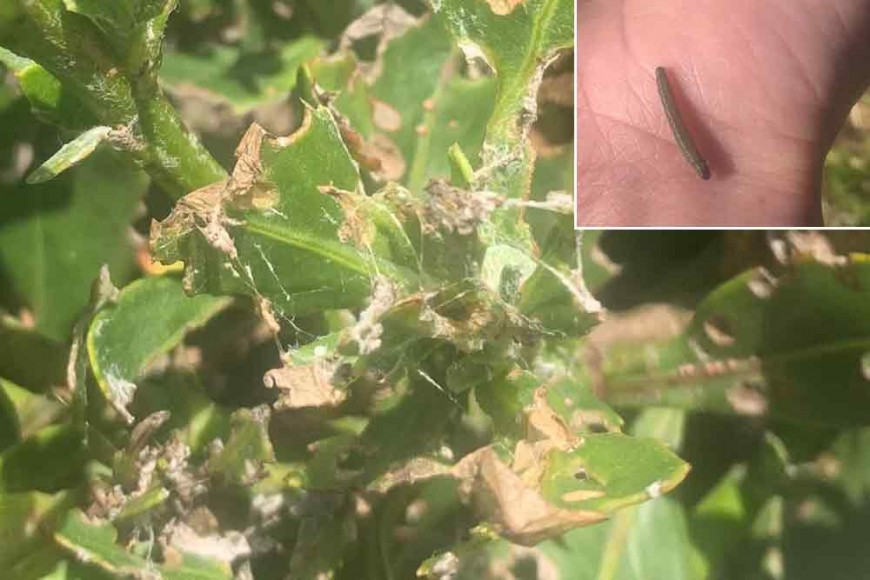It Established After All!

Feeding damage by the boneseed leafroller. Inset: caterpillar
Boneseed is a semi-woody shrub or small tree in the daisy family Asteraceae. In NZ, boneseed forms dense thickets, rapidly replacing low-growing native species in coastal areas, on sand dunes, cliffs, roadsides, margins of estuaries, and inshore habitats. It is a prolific seed producer (up to 50,000 per year per boneseed bush), with long-lived seeds easily spread by birds, possums, and possibly livestock. Seeds germinate readily after fire and ground disturbance. With boneseed having many of the characteristics of serious intractable weeds, biocontrol seemed a good and viable option.
In its native range of South Africa the boneseed leafroller has three generations per year, building up large numbers of caterpillars during summer, which can have a significant impact on their host plant. The moth gets its name from its leafrolling caterpillars, which construct feeding shelters at the tips of boneseed stems by webbing two or more neighbouring leaves together. The caterpillars eat the leaves and stems of boneseed from the safety of this shelter. Feeding by the caterpillars kills the shoot tips and terminal leaves, and mature caterpillars feed on leaves further down the stems, sometimes completely defoliating plants, resulting in reduced seed production and vigour, and sometimes death.
The leafroller was therefore seen as a very promising candidate for the biocontrol of boneseed. A similar number of generations was expected in NZ, with similar or even better damage levels as those observed in the native range. The majority of releases of the leafroller were made in the North Island in Northland and Auckland, although they were also released in Manawatū–Whanganui, the Greater Wellington region, and the Bay of Plenty. In the South Island the leafroller was released in Canterbury as well as further north in the Tasman region.
In November 2011, 4 years after the first releases of the moth took place, we reported that it was well established at three release sites in the North Island (in Northland and the Bay of Plenty) and that it had failed to establish at any of the South Island release sites. It was initially suggested that climate might be responsible for the total failure of the South Island releases, but overwintering experiments suggested this was not the cause. A field study then indicated that predation was limiting establishment of the leafroller. Some generalist parasitoids (at least four, both native and introduced) were already known to attack the eggs and caterpillars in NZ, and it was predicted that establishment would be unlikely in the presence of Argentine ants. However, the boneseed leafroller has outbreaks in its native range despite having plenty of natural enemies there. In some years populations manage to get ahead of the natural enemies, and it was hoped the same would happen in NZ.
The field trial conducted in 2011 also revealed a link between the presence of scale insects on boneseed plants and failure of the moth to establish. The production of honeydew by scale insects attracts honeydew-feeding predatory insects such as wasps and ants. This would make the leafroller caterpillars very vulnerable to predation on plants infested with scale. In fact, establishment success was 70% at sites without scale insects, but zero at sites with high densities of scale. With these findings, no further effort was put into establishing the leafroller in areas where multiple releases had apparently failed.
“Fast forward 11 years, and I received a surprising email from a biosecurity officer, Abbie Roper, from Environment Canterbury in June to say she had found the boneseed leafroller on the Port Hills,” said Ronny Groenteman, a senior researcher in the biocontrol team. “Not only did Abbie find the characteristic feeding damage of the leafroller caterpillars, but she found a culprit too,” Ronny added.
After all these years it was very satisfying for all involved to know that the boneseed leafroller had established in the South Island after all. Sometimes it can take a long time for biocontrol agents to overcome establishment obstacles and build up to noticeable populations. Although we don’t know whether this is a sign of better things to come, the outlook for biocontrol of boneseed is a lot more promising than it was a few months ago!
Key contact

